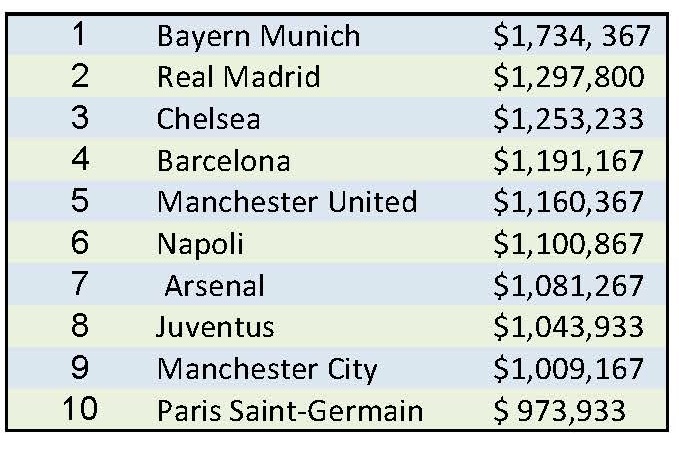By David Owen
January 9 – Details of recipients of a $70 million pot earmarked by FIFA for clubs whose players took part in last year’s World Cup in Brazil have been disclosed, with Germany’s Bayern Munich emerging as comfortably the biggest beneficiary.
Bayern – which supplied 15 of the 736 players in the 32 Brazil 2014 squads, including several members of the victorious German outfit – has been allocated $1,734,367, well over $400,000 clear of Spanish giant Real Madrid in second place.
Chelsea, Barcelona and Manchester United rounded out the Top Five. Nine clubs all told are set to receive in excess of $1 million.
Insideworldfootball noted before the tournament started last June that Bayern were “in pole position” to claim the biggest share of FIFA’s World Cup pot, adding that it looked “a safe bet” that the $1 million barrier would be broken.
Four years ago, when FIFA made $40 million available, Barcelona received the highest payment of $866,267. Then, Bayern was second, Chelsea again third and Real Madrid fifth. The Top Five in 2010 were completed by Liverpool, who have, in effect, been replaced by arch-rivals Manchester United this time.
If there was a surpise in the 2014 Top Ten, it is Napoli in sixth place. However, the club had as many players – twelve – at Brazil 2014 as Juventus and Real Madrid. As many as nine of these, moreover, made it to the World Cup’s knockout stages, in spite of Italy’s early elimination.
The Top Ten Club payouts

Other than that, perhaps the most noteworthy award is $455,000 to CS Herediano of Costa Rica, one of a number of beneficiaries of the Central American nation’s surprise run to the Brazil 2014 quarter-finals. This was enough to leave Herediano perched between Ajax Amsterdam and Turkey’s Fenerbahçe in 34thplace in the list of recipients.
Details were announced by the European Club Association (ECA), which said that 240 club recipients – well over half – were registered with a European national association. This time, 396 clubs affiliated to 57 national associations will receive a share of the benefits – very similar to the 400 clubs from 55 national associations who got money in 2010.
At Brazil 2014, clubs could obtain $2,800 a day for each of their players involved, with the relevant period for the purposes of payment stretching from two weeks before the opening match of the tournament until a day after elimination. Whether a player actually appeared in his country’s matches was not relevant. All clubs for which any given player had been registered in the two years prior to the competition could receive a share of the FIFA payout on a pro rata basis.
Clubs had to agree to a number of undertakings in exchange for the cash. These included: not to be a party to legal proceedings against FIFA as regards the governing body’s regulations on the status and transfer of players and the FIFA statutes; to recognise the Court of Arbitration for Sport (CAS) as sole competent body to decide on disputes between the club and FIFA; and to use the payments “at least partly” for youth and development programmes.
Contact the writer of this story at moc.l1745175405labto1745175405ofdlr1745175405owedi1745175405sni@n1745175405ewo.d1745175405ivad1745175405

